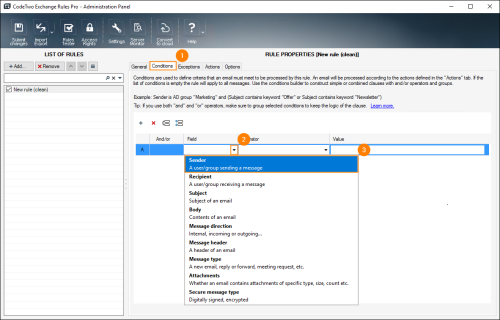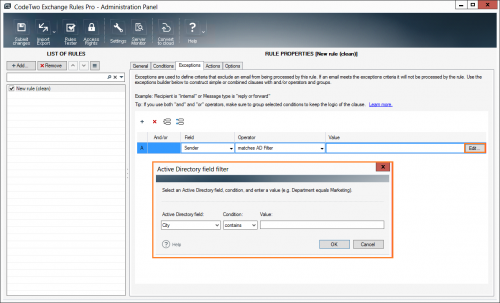This software has been discontinued. If you are looking for a way to manage email signatures and disclaimers in your Exchange Server organization and are using Exchange SE or Exchange 2019/2016 (until they’re supported by Microsoft), try out CodeTwo Email Signatures On-prem.
If you need to manage email signatures, disclaimers and marketing campaigns centrally in Microsoft 365 (Office 365), see our world-leading cloud solution: CodeTwo Email Signatures 365.
Sender
The Sender condition type is used within a rule to define the scope of senders that, once met, will trigger the program to process the rule and perform the associated action(s).
To define the scope of senders within the Conditions tab, expand the Field's context menu and choose Sender (Fig. 1.).

Fig. 1. Choosing the Sender condition.
Warning
If you do not add senders to the list of conditions, the rule will apply to messages sent by all senders.
There are two factors (Fig. 2.) that need to be configured within this condition:
- Operator - defines how the condition will be executed. The execution method may only be set to true.
In this particular condition, the operator may be set to trigger the rule if a sender:
- has a specific email address
- matches an Active Directory user
- matches an Active Directory group (the condition is met only if a message is sent directly from chosen AD group)
- matches an Active Directory filter
- belongs to an Active Directory group
- belongs to an Organizational Unit
- is internal (message is sent from an AD mailbox), external (message is sent from a mailbox hosted outside the organization) or disabled in Active Directory (message is sent from a mailbox disabled in AD).
Important
If external users are added as contacts to your Active Directory, our program treats them as internal users. In such cases, the internal/external parameter might not work as expected. Learn more
- Value - here you define the expected value of the condition that will trigger the rule to apply the associated action. Please note that the Value field depends on the chosen operator.

Fig. 2. Configuring the Sender.
Operator: email address equals
Info
This paragraph refers also to the Recipient condition which is configured in the same way as stated below.
This operator lets you define the email address that will be compared with the email address of the original message Sender while processing rules. If the Sender's email address of the original message matches the address defined in the condition, then the rule will be triggered and the action will be applied to the message.
Once you choose the email address equals operator, you will need to define the value in the separate Email address editor. The editor offers two ways of matching the entered email address with the original message sender (Fig. 3.):
- You can define the exact email address in the List of addresses field (note that you may also use wildcards here). This way, the program will search through all users within the AD database to find this particular email address only. If such email address is found then the rule will be triggered.
- You can define the exact email address in the List of addresses field and mark the checkbox below this field. It will initiate the process of looking through all users within the AD database in search of the particular email address and its associated aliases (alternative email addresses).
Info
The checkbox is not marked by default. If you want the program to search for email address aliases while processing rules, you need to check it.
Warning
Note that in the previous versions of CodeTwo Exchange Rules Pro (prior to 2.0.12), the checkbox worked in the opposite way and was used to prevent the program from searching for email address aliases while processing messages.
The table below shows how the program treats a message for these scenarios:
- Primary SMTP email address and any of its alternative email address (Alias)
- Primary SMTP email address only
- Particular alternative email address only (Alias)
| Configuration in Email addresses editor | Rule triggered / action applied for |
|---|---|
|
Addresses defined in the List of addresses field:
Checkbox marked. |
Primary SMTP email address  |
Each Alias  |
|
|
Addresses defined in the List of addresses field:
Checkbox not marked. |
Primary SMTP email address only  |
Each Alias  |
|
|
Addresses defined in the List of addresses field:
Checkbox not marked. |
Primary SMTP email address  |
Neither Alias  |
Operator: matches AD filter
Info
This paragraph refers also to the Recipient condition which is configured in the same way as stated below.
This operator lets you define a filter based on Active Directory fields that, once met, will trigger the rule and apply the assigned action to the processed messages (Fig. 4.). It means that if you, for example, set up the filter as {First name} - contains - ann, then the rule will be triggered for all users within the environment whose first name defined in AD contains the "ann" entry (Annabelle, Maryann, Susanne, etc.). However, if you set the condition to equals instead of contains, both the rule and the action will apply only to the users whose first name found in AD is "Ann".

Fig. 4. Active Directory field filter editor.
Once you choose matches AD filter operator, you will need to define its parameters in the separate Active Directory field filter editor. The editor comprises three fields:
- Active Directory field - in this area you choose the AD field that will be searched by the filter.
- Condition - the pattern for examining the chosen AD field in search of the defined value. The value of the AD field can be either a part of a string of characters (the contains condition) or needs to meet an exact string of characters (the equals condition).
- Value - the entered string of characters that will be searched for within the chosen AD field using the defined condition pattern.
Tip
You can use the AD filter feature to set conditions or exceptions on empty AD properties. To do so, when configuring the Active Directory field filter (see Fig. 4.) pick a desired AD field, set the Condition to equals and leave the Value field empty. This way, even if a user has the AD field empty, such condition/exception will still be met.
See next
Recipient - this article describes how to configure the Recipient condition.
In this article
